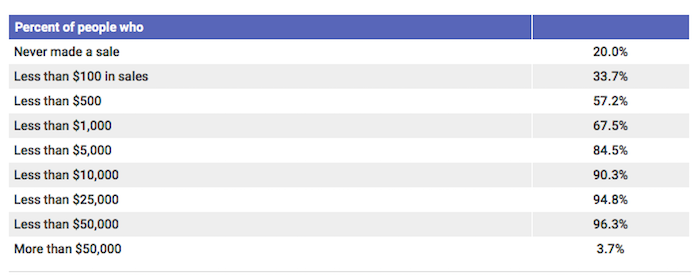Why 80% of participants in an MLM will earn less than 70 cents an hour (before expenses)
Wonder what MLM reps really earn per hour, and how much time they spend on their business? This research by MagnifyMoney uncovers the truth – and it’s not pretty.
Over the past year we’ve published several articles on MLMs, and researched the specific income potential of Arbonne, Herbalife, Stella&Dot, Younique, doTERRA, Juice Plus+, Isagenix, Acti-Labs, LuLaRoe and MONAT.
And everything we have learned confirms that, on average, as many as 99.6% of participants in an MLMs will lose money when all expenses are taken into account.
Now, research by MagnifyMoney seems to back this up. Curious about the return on investment for MLM participants (and how their involvement affects their relationships with family and friends), MagnifyMoney surveyed 1,049 people who had been reps for at least one MLM company over the past five years.
And their conclusion came as no surprise to us, sadly. They discovered that most people could “earn significantly more money in exchange for a lot less time and money invested if they were employed in a minimum wage job”.
That’s right. Most people would be better off working in a minimum wage job than joining an MLM.
So what, specifically, did MagnifyMoney learn?
To sum up MagnifyMoney’s research, it’s extremely hard work making any money in multilevel marketing. They discovered that 20% of participants (18.3% if you exclude people who signed up just for discounts) had never made a sale. And nearly 60% said they’d earned less than $500 in five years.
Using median results, MagnifyMoney calculated that MLM participants worked 14 months out of the five years for 33 hours per month. Overall, they earned a median of $18.18 per month, which translated to $0.67 an hour, before deducting business expenses. (Unsurprisingly, women came out worse than men, with an hourly median wage of $0.56 compared to men’s $0.92.)
To compare, workers in the US’ service sector (the lowest-paid of all major occupations) earn an average of $10.53 an hour. So MLM reps, on average, earn $9.86 an hour LESS than the lowest paid workers in the US – before deducting the costs of running their ‘business’.
MLM reps would be also better off setting themselves up as an Uber driver (the Economic Policy Institute reports that Uber drivers earn an average of $11.77 an hour, after vehicle expenses and fees are taken into account).
Find out why 85% of US Nu Skin distributors earned no commission at all in 2017
So how much do people earn in MLMs?
Here’s a table that shows how much MLM reps told MagnifyMoney they earned in total over five years before deducting expenses:

So, as you can see from the table above, 96.3% of the MLM reps surveyed said they’d earned less than $50,000 over five years before expenses. That’s less than $834 a month. And more than half (57.2%) earned less than $8.34 a month. As we need to remember, that is before their expenses are taken into account.
Please remember too, when you look at the tiny amounts MLM reps are earning, that they are often putting in a lot of hours: 
What expenses do MLM reps have?
So what exactly are MLM reps paying out in business expenses? (Remember, they’re only making an average of 67 cents an hour before these expenses.) According to reps they were encouraged or expected to pay for conferences and training, marketing materials and other expenses, such as delivery.
Indeed, as you can see from this excerpt from the UK company accounts of Forever Living, these types of expenses make a significant portion of an MLM company’s income:
 As you can imagine, with such little income coming in, MLM reps often struggle to cover these expenses. So how do they find the money for them?
As you can imagine, with such little income coming in, MLM reps often struggle to cover these expenses. So how do they find the money for them?
Many participants were forced to go into debt to fund them. 31.6% told MagnifyMoney that they used a credit card, and 9.1% took out a personal loan.
Of those who used a credit card, 15.4% said they hadn’t finished paying off their MLM-related debt. And 63% of these people said they had earned less than $500 from their MLM business. 49% of those who hadn’t finished paying off their credit card debt said they had spent between $100 and $500 on their MLM involvement, overall.
About one-fifth of participants said they had borrowed money from friends and family. And that borrowing had a negative impact on their relationships:
- 30.9% of participants who persuaded a friend or relative to lend them money said they ended up losing a friendship.
- 40.2% said they had argued with close family and friends over the time or money invested.
MLM reps admit lying about their success
As we reveal at length here, MLM reps are often encouraged by their uplines to lie about their success. (They also often feel compelled to cover up their failure – ‘faking it’ until they make it.)
So it wasn’t surprising to us that 22% of the MLM participants who spoke to MagnifyMoney admitted to lying to friends and family about the money they’d earned or invested in their MLM business. They had also lied about their income and investment to make sales and recruit.
36.5% of married men and 20.1% of married women (and 35.2% of those who borrowed money from their families and friends) admitted to lying to their loved ones about how much they spent or earned to participate.
If lying wasn’t bad enough, joining an MLM had led many to fight with their friends and family:
- 42.7% of married men and 20.1% of married women said that they’d argued about how much time or money they’d invested.
- 42% of MLM participants who borrowed money from loved ones to cover some or all of their participation costs also admitted fighting.
MLMs don’t work for 99.6% of reps on average
As we mentioned at the beginning of this article, nothing in the research by MagnifyMoney surprised us. We’ve long known that MLMs don’t work for 99.6% of participants on average.
Their entire business is set up to benefit the tiny percentage of people at the very top of the company’s pyramid-shaped earning structure. For the majority of people who buy into the dream of making easy money from home, the reality is, as we can see, a LOT of work for very little in return.
And often, that reality also includes falling into debt, and lying to and becoming alienated from friends and family – the people who genuinely do care about you (unlike your wonderful new MLM pals who’ll drop you the moment you fail or leave the company).
It’s not the MLM business that failed; its you
If you do fail in an MLM you’re often told that it’s not the business that failed; it’s you. You didn’t work hard enough. Didn’t want it enough. Weren’t positive enough.
As we explain here, MLMs can only exist when everyone buys into the dream. Like the emperor’s new clothes, they can’t afford for anyone to discover that the emperor is really naked. So companies, uplines and other desperate reps quickly discredit and turn against anyone who sees through the lies. Or proves that the business model is flawed.
Consequently, former MLM reps are hit with a double whammy of self-doubt. Not only have they failed to make their ‘business’ (really a rep is just an unpaid sales rep with no rights) work, but now they’re told that they’re the reason for their failure. That their mindset is fundamentally flawed.
Read more about MLMs
We’re delighted to see an increasing number of organisations and individuals start to look into and speak out about MLMs. If you’d like to learn more about them, here are some of our recommended sources:
- Elle Beau
- The Anti-MLM Coalition
- Botwatch
- Timeless Vie
- Anti-MLM Reddit
- Pyramid Scheme Alert
- ‘MLM’ The American Dream Made Nightmare
- Ethan Vanderbuilt
- Betting on Zero
- MLM Lies Exposed
- The Art of Manliness
We also highly recommend checking out new podcast The Dream, which investigates MLMs in depth.
Discover more about MLMs on our site
We have a growing number of features on MLMs on our own site. If you’d like to read more about how MLMs operate, we recommend checking out these revealing income disclosure investigations:
- How can you make money with MLM LuLaRoe? Why the sums don’t add up
- How much money can you really make working for MLM Arbonne?
- How much money can you really make working for MLM Stella&Dot?
- Read the complete lowdown on MLM Juice Plus+
And these income investigations:
- How much money can you really make working for MLM Herbalife?
- How much can you earn with MLM Younique? (Why it’s probably less than $14 a month)
- How much money can you earn with MONAT, the new MLM coming to the UK?
- How much money can you earn with MLM Isagenix?
Here some of our articles looking at the MLM business model:
- The 10 ugly truths MLMs don’t want you to know
- Fake it ’til you make it – how MLM reps lie to recruit and sell
- Thinking of joining an MLM? Read the truth behind the ‘income opportunity’
- Seven lies an MLM rep will tell you – and the REAL truth you need to know
And finally, some more:
- Is no tragedy safe from being turned into a sales opportunity by MLM reps?
- Why there’s no such thing as a free MLM car
- Are MLMs the modern day snake oil?
- Why any competition that allows MLMs is basically fixed
Photo by Jacob Townsend










